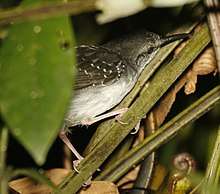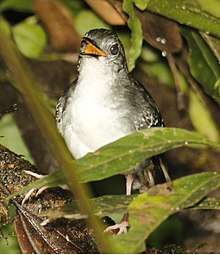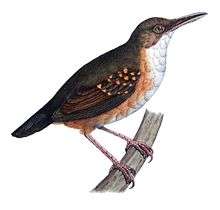Silvered antbird
The silvered antbird (Sclateria naevia) is a passerine bird in the antbird family, the only member of the genus Sclateria. It is a resident breeder in tropical South America from Colombia and Trinidad south to Peru, Bolivia and central Brazil.


| Silvered antbird | |
|---|---|
 | |
| Female | |
| Scientific classification | |
| Kingdom: | Animalia |
| Phylum: | Chordata |
| Class: | Aves |
| Order: | Passeriformes |
| Family: | Thamnophilidae |
| Genus: | Sclateria Oberholser, 1899 |
| Species: | S. naevia |
| Binomial name | |
| Sclateria naevia (Gmelin, 1788) | |
| Synonyms | |
|
Sitta naevia | |
This is a skulking terrestrial bird of wet shaded areas, such as in undergrowth or under overhanging vegetation near streams, lagoons or swamps. It is usually found in pairs, foraging on the ground for small insects and other arthropods taken from leaf litter or the water's surface.
The silvered antbird is typically 15 cm long, and weighs 20 g. The adult male of the nominate northern form S. n. naevia has dark grey upperparts and dusky wings with two rows of white spots. The underparts are white, extensively and broadly streaked with grey. The female has dark brown upperparts, with buff wing spots and extensively grey-streaked underparts.
Males of the distinctive Amazonian subspecies S. n. argentata have the flanks and upper chest grey-white with grey mottling, and the females have white central underparts with rufous sides to the head, neck and body.
The silvered antbird has a loud pi-pi-pi-pi-pi-pi-pi call, often the first indication of its presence in its difficult habitat.

References
- BirdLife International (2012). "Sclateria naevia". IUCN Red List of Threatened Species. 2012. Retrieved 26 November 2013.CS1 maint: ref=harv (link)
- ffrench, Richard (1991). A Guide to the Birds of Trinidad and Tobago (2nd ed.). Comstock Publishing. ISBN 0-8014-9792-2.
- Hilty, Steven L (2003). Birds of Venezuela. London: Christopher Helm. ISBN 0-7136-6418-5.
